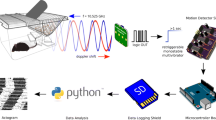Abstract
A new method for continuous in-cage monitoring of the activity of rats using passive sensors to detect the animals' infrared emissions, and its usefulness for toxicological screening tests is described. In order to obtain baseline values for toxicological tests, the differences between day and night activity, adaptation to changing day/night rhythm, the effects of handling the animals (measurement of body weight, food and water consumption) and the effect on activity patterns of the female estrus cycle were investigated. In two separate experiments, single doses of acetanilide and phenylmercuric acetate were administered. Passive infrared monitoring of motor activity proved to be a sensitive and discriminating method suitable for quantitative and qualitative assessment of acute toxic effects.
Similar content being viewed by others
References
Alder S, Zbinden G (1983) Neurobehavioral tests in single- and repeated-dose toxicity studies in small rodents. Arch Toxicol 54: 1–23
Alder S, Candrian R, Elsner J, Zbinden G (1986) Neurobehavioral screening in rats: validation study. Meth Find Exp Clin Pharmacol 8 (5): 279–289
Ball J (1926) The female sex cycle as a factor in learning in the rat. Am J Physiol 78: 533–536
Barnett SA, McEwan IM (1973) Movements of virgin, pregnant and lactating mice in a residential maze. Physiol Behav 10: 741–746
Birke LIA, Archer J (1975) Open-field behavior of oestrous and dioestrous rats: evidence against an “emotionality” interpretation. Anim Behav 23: 509–512
Bolles RC (1963) A failure to find evidence of the estrous cycle in the rat's activity level. Psychol Rep 12: 530
Burke AW, Broadhurst PL (1966) Behavioral correlates of the oestrous cycle in the rat. Nature 209: 223–224
Finger FW (1961) Estrous activity as a function of measuring device. J Comp Physiol Psychol 54: 524–526
Finger FW (1969) Estrus and general activity in the rat. J Comp Physiol Psychol 68: 461–466
Fryer TB, Lund GF, Williams BA (1978) An inductively powered telemetry system for temperature, ECG and activity monitoring. Biotelemetry and Patient Monitoring 5 (2): 53–76
Gerber GJ, O'Shaughnessy D (1986) Comparison of the behavioral effects of neurotoxic and systemically toxic agents: how discriminatory are behavioral tests neurotoxicity? Neurobehav Toxicol Teratol 8 (6): 703–710
Gerber GJ, Nawiesniak E, Ratte S, O'Shaughnessy D (1985) Triethyltin-produced decrease and recovery of wheel running and food-reinforced lever pressing in rats. Neurobehav Toxicol Teratol 7 (5): 433–438
Gomez JG (1984) Use of ultrasound in movement studies. Revista Española de Fisiologia 40 (3): 353–357
Guttman R, Lieblich I, Gross R (1975) Behavioral correlates of estrous cycle stages in laboratory mice. Behav Biol 13: 127–132
Kleinlogel H (1983) The female rat's sleep during oestrous cycle. Neuropsychobiology 10 (4): 228–237
Lorenzetti OJ, Rogers RW (1970) A simple ultrasonic meter for measuring activity in small laboratory animals. Med Biol Eng 8 (4): 413–414
Mardsen CA, King B (1979) The use of doppler shift radar to monitor physiological and drug induced activity patterns in the rat. Pharmacol Biochem Behav 10 (5): 631–635
Martin JR, Bättig K (1980) Exploratory behaviour of rats at oestrus. Anim Behav 28: 900–905
Mullenix P (1981) Structure analysis of spontaneous behavior during the estrous cycle of the rat. Physiol Behav 27 (4): 723–726
Petry H (1982) Measurement of animal movements by magnet induction. Z Tierphysiol 47 (4): 210–220
Ruedin P, Bisang J, Waser PG, Borbély AA (1978) Sleep telemetry in the rat: I. A miniaturized FM-AM transmitter of EEG and EMG. Electroencephalogr Clin Neurophysiol 44: 112–114
Slonaker JR (1924) The effect of pubescence, oestruation and menopause on the voluntary activity in the albino rat. Am J Physiol 68: 294–315
Tanger HJ, Vanwersch RA, Wolthuis OL (1984) Automated quantitative analysis of coordinated locomotor behavior in rats. J Neurosci Meth 10 (3): 237–245
Teicher MH, Green WT (1977) A digital readout vibrational activity monitor for newborn animals. Physiol Behav 18 (4): 747–750
Tobler I, Borbély AA (1980) Effect of delta sleep inducing peptide (DSIP) and arginine vasotocin (AVT) on sleep and motor activity in the rat. Waking and Sleeping 4: 139–153
Vigouroux M, Cattarelli M (1979) Ultrasonic detection of rat movements in a straight runway. Physiol Behav 23 (6): 1025–1027
Wang GH (1923) The relation between “spontaneous” activity and estrus cycle in the white rat. Comp Psychol Monogr 2: 1–27
Weasner MH, Finger FW, Reid LS (1960) Activity changes under food deprivation as a function of recording device. J Comp Physiol Psychol 53: 471–474
Author information
Authors and Affiliations
Rights and permissions
About this article
Cite this article
Tamborini, P., Sigg, H. & Zbinden, G. Quantitative analysis of rat activity in the home cage by infrared monitoring. Application to the acute toxicity testing of acetanilide and phenylmercuric acetate. Arch Toxicol 63, 85–96 (1989). https://doi.org/10.1007/BF00316429
Received:
Accepted:
Issue Date:
DOI: https://doi.org/10.1007/BF00316429




